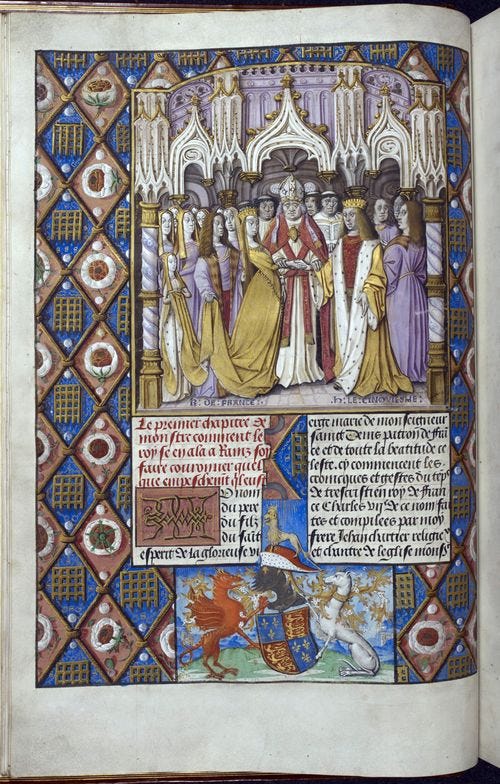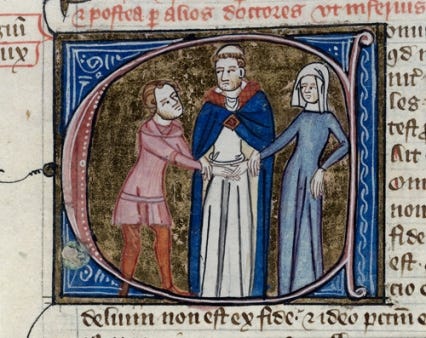Medieval weddings
When Richard was sailing for the Holy Land on Crusade, he stopped in Cyprus. While he was there, he got married at Limassol Castle, right on the beach. I thought it might be fun to review medieval weddings.
Medieval weddings were typically arranged affairs, especially for royalty—people rarely married for love. Instead, they married to cement alliances. Richard had, in fact, been engaged to Alice, the daughter of King Louis VII, for over 20 years! He never completed the marriage and did not want to. Instead, he became engaged to Berengaria of Navarre, which protected his southern border. It is unclear whether he actually desired her or whether this was purely a strategic move on his part, but he definitely did not want to marry Alice. He and Louis’s son, the then-King of France, Philip II, sailed on Crusade and stopped in Messina, Sicily, before Richard headed to Cyprus. While in Sicily, Richard dissolved his engagement to Alice, Philip’s sister. It was a very acrimonious affair, involving Richard paying Philip a large sum of money, and making an enemy for life.
Arranged marriages at young ages were quite common. Richard’s brother Henry, the heir apparent to Henry II, was betrothed at age five to Margaret of France, another daughter of Louis VII, at age two! Margaret’s dowry was the Vexin, an important and highly-contested piece of land that controlled the route between Paris and Rouen. Richard’s sister Joanna became Queen of Sicily by marriage at age eleven. Henry II’s mother Matilda was engaged at eight and married at twelve to Henry V, the Holy Roman Emperor. Marriages and engagements at early ages was normal. Children were tools as well as family.
Royal weddings were usually heavily negotiated. Of particular interest was the bride’s dowry—the gift from the bride’s family to the new household—which usually represented her share of her inheritance from her parents, usually lands and/or money. In return she gained dower rights—rights to income or inheritance from her husband's land, in the event that her husband passed before her.
Before a marriage could take place, typically the “banns” would be published. Traditions and religious proscriptions varied over time, but generally the “banns” - an announcement of marriage—were published three times, onces per week, so that anyone could object to the marriage. (I have always found the word “banns” to be strangely counterintuitive, for what it’s worth).
One of the most common reasons for objecting to a marriage was consanguinity. One was theoretically not allowed to marry someone you were related to. The degree of relation changed over time, and had varying levels of strictness applied. In 1215 Pope Innocent changed the church’s view by reducing the prohibited degrees of relationship from seven to four.1 That is, one could now marry a sixth cousin but not a third cousin. The royal families of Europe were quite intertwined by Richard’s day, and so this rule unsurprisingly became a way for marriages to be annulled then (there was no divorce, per se, then). In fact, Richard’s mother Eleanor’s marriage to Louis VII, which was not working out, was dissolved on the basis of consanguinity (they were third cousins, I believe).
There were times of year when by church decree, a marriage could not take place, for example, during Advent or Lent. Richard and Berengaria were in Sicily during Lent and so they were unable to be married there. After Richard conquerered Cypress he then held the wedding with Berengaria.
We don't know a great deal about the wedding ceremony in Cyprus, but we can expect that it followed traditional medieval patterns. Announcements would have been made. The wedding was typically not performed in the church. The vows were celebrated at the door of the church, and then the participants would go into the church to celebrate mass.
Today's tradition is that the bride would wear white to symbolize chastity. During the Middle Ages, the color was blue—so the common bridal dress would have been blue. 2
Following the ceremony, there would have been a lavish feast.
Eventually, the bride and groom would be led by a train or a parade to their bedroom. This was typically a very jovial affair. Depending on the era, clothes might be torn off by the crowd, or the bride and groom might throw off their clothes, and throw them to the parade. This is the origin of the garter belt or bouquet toss ceremony, often performed today.
Particularly for royal weddings, it was very important that the marriage was consummated. If the marriage was not consummated, it could be challenged and might not be legally binding. As a result, there was usually some form of “public bedding”—that is to say, witnesses would remain in the room with the bride and groom while the marriage was consummated. Depending on the era and the circumstances, the intrusiveness of the observation might be higher (actively watching) or lower (bridge and groom behind curtains on the bed, witnesses at the edges of the room). In any case, quite intrusive by modern standards! But standards of privacy were different then, and so to medieval tastes, it may not have been quite as strange to them as it would be to us.
The witnesses to this event were quite important in the case in case the marriage might later be challenged, which often occurred with royal weddings!
Guest would often bring little cakes, and the cakes would be stacked on top of each other. The bridge and groom will try to kiss each other over the stack of cakes. This is the origin of today's wedding cake concept.
And then, especially in the case of royal weddings, everyone hopes for an heir.
In Richard’s case, no such heir would be forthcoming, and after his death, England would be left with King John.
https://thehistoryjar.com/2017/07/30/rules-for-medieval-marriage/
https://engelskhistoria.wordpress.com/2015/05/11/the-medieval-wedding/







